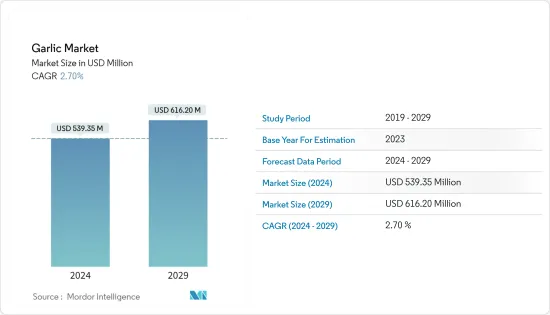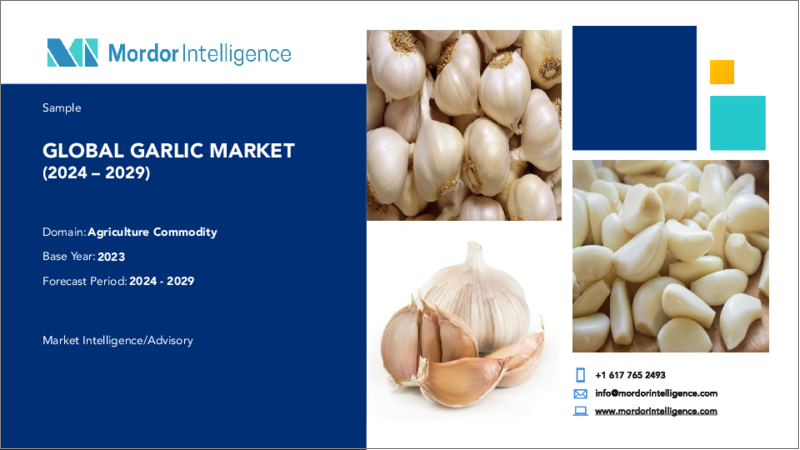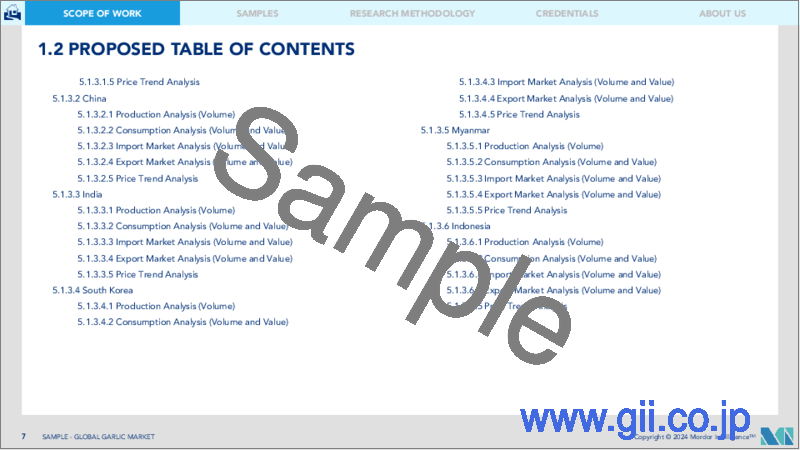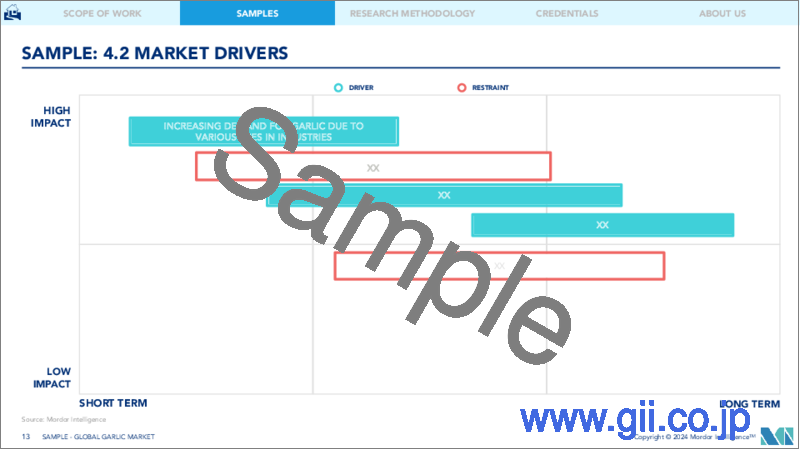|
|
市場調査レポート
商品コード
1438265
ニンニク:市場シェア分析、業界動向と統計、成長予測(2024-2029年)Garlic - Market Share Analysis, Industry Trends & Statistics, Growth Forecasts (2024 - 2029) |
||||||
カスタマイズ可能
適宜更新あり
|
|||||||
| ニンニク:市場シェア分析、業界動向と統計、成長予測(2024-2029年) |
|
出版日: 2024年02月15日
発行: Mordor Intelligence
ページ情報: 英文 125 Pages
納期: 2~3営業日
|
- 全表示
- 概要
- 目次
ニンニク市場規模は2024年に5億3,935万米ドルと推定され、2029年までに6億1,620万米ドルに達すると予測されており、予測期間(2024年から2029年)中に2.70%のCAGRで成長します。

風味や味に妥協することなく健康的なインスタント食品を求める消費者の需要の高まりと、味を変えることなく保存安定性を保つニンニクの能力が市場の成長を促進しています。にんにくの需要は、ピクルスやカレー製品の売り上げが多い加工業などさまざまな業界で高まっています。ニンニクは、ペーストや医薬品などのハーブ製品にも広く使用されています。この野菜は、さまざまな料理の香味料として使用されることでも有名です。しかし、さまざまな気候的および政治的要因によるニンニクの価格変動が市場の成長を妨げています。
ニンニクは多くのアジア諸国で最も重要な作物です。したがって、ニンニクの消費に関しては、アジア太平洋が世界市場を独占しています。ニンニクは各家庭で消費され、加工産業でも使用されます。食品業界やヘルスケア業界でのさまざまな用途に起因するガーリックパウダーの膨大な需要が市場を牽引しています。また、チャツネ、ピクルス、カレー粉、カレー野菜、肉および肉製品の調製物、トマトケチャップなどのさまざまな食品の調製物にも使用されます。
食糧農業機関によると、ニンニクの最大の生産国は中国で、2020年の生産量は2,070万トン、次いでインドの290万トンだといいます。他の上位3つのニンニク生産国には、韓国、エジプト、ロシアが含まれます。
ニンニク市場動向
産業における多様な用途によりニンニクの需要が増加
WHOによると、ニンニクを定期的に摂取するとがんのリスクが軽減される可能性があります。ニンニクは生で消費されるほか、加工産業でも使用されます。また、チャツネ、ピクルス、カレー粉、カレー野菜、肉および肉製品の調製物、トマトケチャップなどの幅広い食品調製物にも使用されます。
生のニンニクは、ガーリックパウダー、ガーリックソルト、ガーリックビネガー、ガーリックチーズクルトン、ガーリックポテトチップス、ガーリックブレッドなどの第二世代製品に使用されています。したがって、ニンニク市場は、予測期間中に一定の需要を生み出すことが予想されます。これとは別に、ガーリックパウダーは漢方薬として使用されます。家庭料理ブームによりニンニクの需要が高まり、その後の量の増加は、供給業者がこの課題に取り組んでいることを示しています。
ITC Trade Mapが公開したデータベースによると、2021年の世界のニンニク輸入額は32億4,267万9,000米ドルで、前年比約5.3%増加しました。ニンニクは世界貿易において非常に重要かつ主要な役割を果たしています。これは、作物の収穫面積の増加によって証明されており、2018年、2019年、2020年にはそれぞれ1,585,933ヘクタール、1,629,344ヘクタール、1,631,869ヘクタールを占めました。
FAOによれば、2020年の世界のニンニクの総生産量は2,810万トンで、2018年から約3.9%増加しました。
アジア太平洋がニンニク市場をリード
アジア太平洋がニンニク市場を独占しており、中国だけで世界のニンニク生産量の80%以上を占めています。食糧農業機関(FAO)によると、2020年の中国のニンニク生産量は2,080万トンで、2019年の2,070万トンでした。中国とインドは、アジア太平洋におけるニンニク抽出物の最大の消費国2位です。これらの地域では、さまざまな料理を作る際の基本的な材料として使用されています。ニンニクは気温12度から24度の気候で最もよく栽培されます。
中国は世界最大のニンニクの生産国であり、輸出国でもあります。 ITCトレードマップデータによると、2021年の輸出額は20億3,358万5,000米ドルと評価され、2019年の19億9,114万2,000米ドルと比較して約2.1%増加しました。現在のニンニクの供給源は、金郷、沛州、山東省、江蘇省、河南棲県、中蒙、河南省の農園です。中国産ニンニクの最大の輸入国はインドネシアで、次いでベトナム、マレーシアとなっています。欧州は中国からのニンニクの重要な輸入国でもあります。
ニンニクはアジアのほとんどの国で最も重要な作物です。したがって、アジア太平洋地域がニンニク産業の大きなシェアを占めています。ニンニクはほぼすべての家庭で消費されており、食品産業でも使用されています。ピクルス、チャツネ、カレー粉、カレー野菜、肉および肉製品の調理品、トマトケチャップ、その他の食事にはすべてニンニクが含まれています。これらはアジア諸国で多く消費されています。このような要因が市場の成長に貢献しています。
その他の特典
- エクセル形式の市場予測(ME)シート
- 3か月のアナリストサポート
目次
第1章 イントロダクション
- 調査の前提条件と市場の定義
- 調査範囲
第2章 調査手法
第3章 エグゼクティブサマリー
第4章 市場力学
- 市場概要
- 市場促進要因
- 市場抑制要因
- バリューチェーン分析
第5章 市場セグメンテーション
- 地域(生産分析、数量・金額による消費分析、数量・金額による輸入市場分析、数量・金額による輸出市場分析、および価格動向分析)
- 北米
- 米国
- メキシコ
- カナダ
- 欧州
- スペイン
- ウクライナ
- フランス
- 英国
- ロシア
- アジア太平洋
- ベトナム
- 中国
- インド
- 韓国
- ミャンマー
- インドネシア
- 南米
- ブラジル
- アルゼンチン
- その他南米
- 中東とアフリカ
- 南アフリカ
- エジプト
- その他中東とアフリカ
- 北米
第6章 市場機会と将来の動向
The Garlic Market size is estimated at USD 539.35 million in 2024, and is expected to reach USD 616.20 million by 2029, growing at a CAGR of 2.70% during the forecast period (2024-2029).

The rising consumer demand for healthy convenience foods without compromising on their flavor and taste, coupled with the ability of garlic to remain shelf stable without altering its taste, drives its market growth. The demand for garlic is rising in various industries, such as processing industries, where the sales of pickles and curry products are high. Garlic is also widely used in herbal products, including pastes and medicines. The vegetable is also famous for its use as a flavoring agent in various cuisines. However, fluctuations in the price of garlic owing to various climatic and political factors are impeding its market growth.
Garlic is the most important crop in many Asian countries. Hence, Asia-Pacific dominates the global market in terms of the consumption of garlic. Garlic is consumed in every home and used in the processing industries. The huge demand for garlic powder due to its varied applications in the food and healthcare industries is driving the market. It is also used in various food preparations like chutneys, pickles, curry powders, curried vegetables, meat and meat product preparations, tomato ketchup, etc.
China is the leading producer of garlic, with production amounting to 20.7 million metric tons in 2020, followed by India with 2.9 million metric tons, according to the Food and Agriculture Organization. The other three top garlic-producing countries include South Korea, Egypt, and Russia.
Garlic Market Trends
Increasing Demand for Garlic Due to Various Uses in Industries
According to WHO, regular intake of garlic may lead to a reduction in cancer risk. Garlic is consumed both fresh and used in the processing industry. It is also used in a wide range of food preparations like chutneys, pickles, curry powders, curried vegetables, meat and meat product preparations, tomato ketchup, etc.
Raw garlic is used in second-generation products like garlic powder, garlic salt, garlic vinegar, garlic cheese croutons, garlic potato chips, garlic bread, etc. Hence, the garlic market is expected to generate constant demand over the forecast period. Apart from this, garlic powder is used as herbal medicine. The boom in home cooking has boosted the demand for garlic, and subsequent volume increases have demonstrated that suppliers are up to the challenge.
According to a database published by ITC Trade Map, the global import value of garlic was USD 3,242,679 thousand in the year 2021, an increase of approximately 5.3% from the previous year. Garlic plays a very important and major role in world trade. This is demonstrated by the increase in the area harvested for the crop, accounting for 1,585,933, 1,629,344, and 1,631,869 hectares in 2018, 2019, and 2020, respectively.
As per FAO, in 2020, the total production of garlic globally was 28.1 million metric tons, an increase of approximately 3.9% from 2018. This substantial increase in the area harvested and production is due to the high demand for garlic owing to its varied applications in the food and healthcare industries, which are driving the market globally.
Asia-Pacific Leads the Garlic Market
Asia-Pacific dominates the garlic market, with China alone accounting for more than 80% of the global garlic production. According to Food and Agriculture Organization (FAO), in 2020, garlic production in China was 20.8 million metric tons, compared to 20.7 million tons in 2019. China and India are the two largest garlic extract consumers in the Asia-Pacific. In these regions, it is employed as a basic ingredient in the making of various cuisines. Garlic is best grown in a climate with temperatures ranging from 12 to 24 degrees Celsius.
China is the world's largest producer and exporter of garlic. Its export for 2021 was valued at USD 2,033,585 thousand, an increase of approximately 2.1% from 2019, which was valued at USD 1,991,142 thousand, as per the ITC Trade Map data. Plantations in Jinxiang, Peizhou, Shandong, Jiangsu, Qixian Henan, Zhongmou, and Henan provide the current garlic supply. Indonesia is the top importer of Chinese garlic, followed by Vietnam and Malaysia. Europe is also a significant importer of garlic from China.
Garlic is the most vital crop in most Asian countries. Thus, the Asia-Pacific region accounts for a major share of the garlic industry. Garlic is consumed in almost every household and is also used in the food industry. Pickles, chutneys, curry powders, curried vegetables, meat and meat product preparations, tomato ketchup, and other meals all contain garlic; these are highly consumed in Asian countries. Such factors are contributing to the growth of the market.
Additional Benefits:
- The market estimate (ME) sheet in Excel format
- 3 months of analyst support
TABLE OF CONTENTS
1 INTRODUCTION
- 1.1 Study Assumptions and Market Definition
- 1.2 Scope of the Study
2 RESEARCH METHODOLOGY
3 EXECUTIVE SUMMARY
4 MARKET DYNAMICS
- 4.1 Market Overview
- 4.2 Market Drivers
- 4.3 Market Restraints
- 4.4 Value Chain Analysis
5 MARKET SEGMENTATION
- 5.1 Geography (Production Analysis, Consumption Analysis by Volume and Value, Import Market Analysis by Volume and Value, Export Market Analysis by Volume and Value, and Price Trend Analysis)
- 5.1.1 North America
- 5.1.1.1 United States
- 5.1.1.2 Mexico
- 5.1.1.3 Canada
- 5.1.2 Europe
- 5.1.2.1 Spain
- 5.1.2.2 Ukraine
- 5.1.2.3 France
- 5.1.2.4 United Kingdom
- 5.1.2.5 Russia
- 5.1.3 Asia-Pacific
- 5.1.3.1 Vietnam
- 5.1.3.2 China
- 5.1.3.3 India
- 5.1.3.4 South Korea
- 5.1.3.5 Myanmar
- 5.1.3.6 Indonesia
- 5.1.4 South America
- 5.1.4.1 Brazil
- 5.1.4.2 Argentina
- 5.1.4.3 Rest of South America
- 5.1.5 Middle East and Africa
- 5.1.5.1 South Africa
- 5.1.5.2 Egypt
- 5.1.5.3 Rest of Middle East and Africa
- 5.1.1 North America






